
AS A YOUNG car nerd growing up in the ’90s, Sydney was a pretty good place to call home. Back then the harbour city still had its own motor show and my old man made a point of taking me every year. I was almost 11 years old when we visited in 1997, and my tiny mind was blown by the Peugeot 306 GTI 6 – a sporty hatchback with an outrageously exotic (for the time) six-speed manual gearbox – and I’ve been an undercover Francophile ever since.
Yet more than two decades later I still haven’t owned a French car. Gallic hot hatches continue to represent my go-fast interests, but with a nine-month-old baby in the house, a firmly sprung five-door with bucket seats wasn’t the most obvious choice in family transport terms.
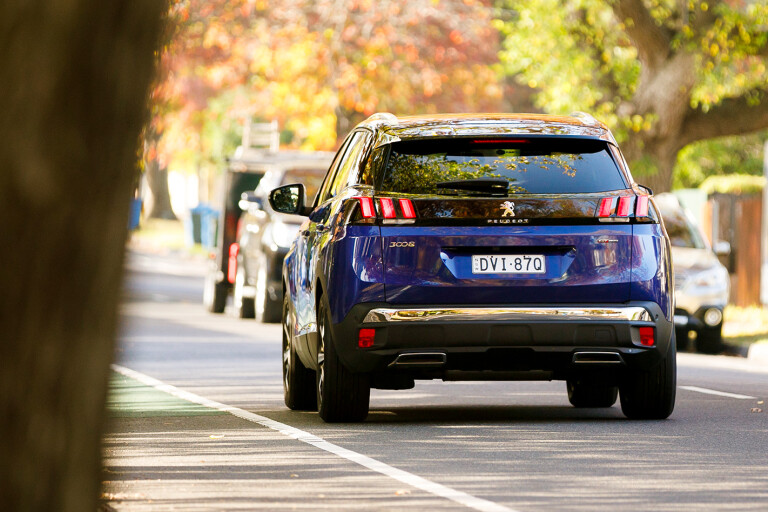
And so it is that my first French fling – albeit a temporary one – is with a Peugeot 3008. A far cry from the 306 of my childhood it may be, but a car I’m no less excited to park on my driveway.
It was at the Paris motor show almost two decades after the 306 first broadened my horizons that this charming Pug of an altogether different genre reset my preconceptions about what a mid-size SUV could be. Here was a practical tool with likably thoughtful functionality that also modelled one of the most interesting and detailed interior executions of any new car on sale.
I still had the academically brilliant yet austere second-gen Volkswagen Tiguan fresh in my mind at the 3008’s debut, and the Pug felt like a shot of adrenaline for the segment even on first encounter. It went on to impress the judges at Wheels Car of the Year toward the end of 2017, and a similar car to my new long-termer fared well in a comparison test shortly afterwards (Wheels Yearbook, 2017).
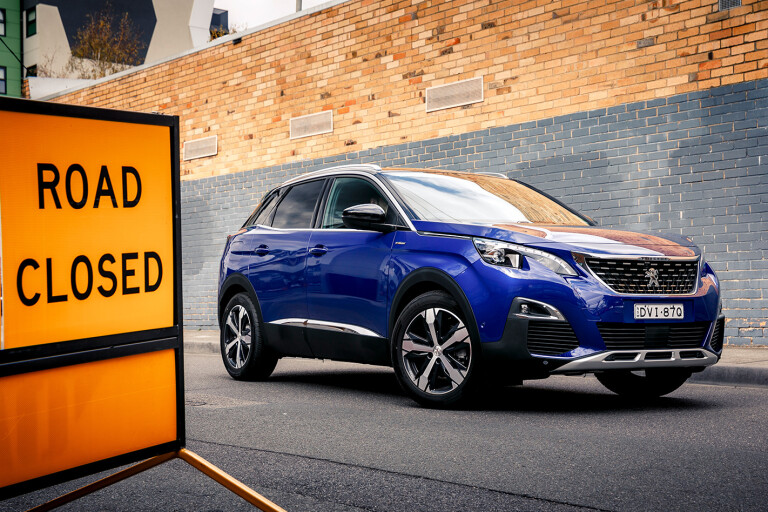
And so it falls to me to explore the ownership experience over the next few months, something first impressions suggest will be an enjoyable thing to do. Our 3008 is a top-spec petrol-powered GT-Line that sits just below the range-topping GT diesel. Its 1.6-litre four-cylinder turbo produces 121kW and 240Nm and pairs with an excellent Toyota-sourced six-speed automatic, just like all other 3008s.
At $44,990 it isn’t exactly cheap for a front-drive-only model. That retail price rises to $49,680 as tested with the addition of metallic paint at $690, and quilted leather trim with electric driver’s seat adjustment and a massage function for $4000. But the GT-Line does boast a feature-packed equipment list including keyless entry and start, LED lighting with cornering function, adaptive cruise control with AEB and other active safety systems, an electric tailgate with gesture control, 3D navigation, digital radio and plenty more besides.
If I were buying, I’d go without the cowhide covers and keep the lovely grey denim upholstery that’s fitted as standard to match the textural dashboard and door trim inserts.
Delving into the pros and cons of its drive experience will come after a little more time to evaluate, though I’ve already gelled with the quickness of its steering and the feel of its tiny tiller that’s squared off at the top and bottom. Peugeot’s controversial head-up digital instrument display really works for me here, and adds to the 3008’s long list of charismatic points of difference.

That said, these first few weeks of getting to know one another haven’t been entirely champagne and croissants. It’s safe to say I will never again use the car’s Sport mode because of its laughably bad synthesised engine note. The Bluetooth phone connectivity struggles with the transition from handset to car when getting into the 3008 while on a call, and there’s a slight amount of play in the driver’s seat base that I can feel as a rocking motion when driving over speedbumps.
But none of this has taken too much of the shine off my growing affection for DVI-87Q. It will be interesting to see how my highly anticipated French companion acquits itself over the months to come.
Update #2
SITREP from inside the Lewis household: life is good. French-Australian relations are in rude health with our Magnetic Blue companion slipping effortlessly into the daily routine.

After a month and a bit together the 3008 and I are at a comfortable spot. We understand each other. I’ve now sampled the function of every button, cycled through all available menu options – of which there are many millions – and found a Goldilocks set-up that fits me just right.
My favourite configuration keeps the customisable digital dashboard showing speed and trip data, and a neatly stylised road map in the centre to make finding side streets a cinch. That leaves the central screen free to display radio station and track name data most of the time, with climate control settings and connectivity options at the ready if need be.

Switching between pages on the centre display is done using seven ‘finger’ buttons mounted across the dash below. They’re one of my favourite design features inside the 3008, but it can be hard to quickly locate the one you need when on the move as they’re all the same shape and size and have only a small icon with no text to identify them. I’ve learned that a three-finger prod of the touchscreen brings up the same options as selectable soft buttons, which is a handy trick to know.
You might assume I stumbled upon this nifty shortcut while curiously flipping through the user handbook, but that would be far too obvious. In fact, the hard-copy manual delivered in my 3008’s glovebox
is entirely and inexplicably printed in Arabic…

I had to laugh. My contact at Peugeot saw the amusing side too, then set about sourcing a local version for me. I’ll be sure to share any other pro-tips once it arrives.
I’ve also come around to the Pug’s relatively modest level of performance. I’ll admit to feeling a little underwhelmed by its 240Nm of twist the first time I put my foot down, but I’ve since changed my mind.
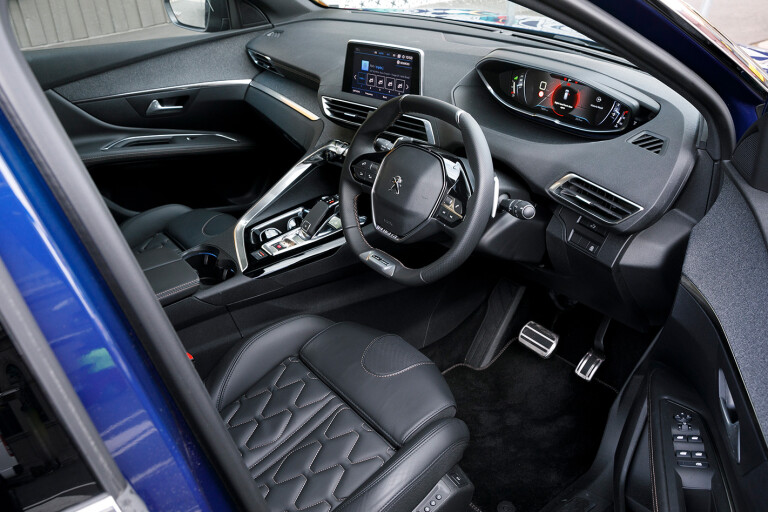
It’s perfectly adequate for the job this car sets out to do. What has been a little disappointing up until now is its fuel economy. The last tank of PULP (it won’t accept less than 95RON) disappeared at a rate of 11.0L/100km, which is higher than hoped even if it was achieved in mostly peak-hour commuting.
But the outlook is still rosy. I don’t mind its slightly busy ride or the somewhat noisy mud and snow tyres, about which I’ll go into more detail later. We’ve moved past the early awkwardness and hit our stride.
There’s a satisfying user friendliness about this car once its quirks have been discovered and adapted to, and there’s something loveably human about that.
Update #3
OWNING a 3008 is fun, I’ve come to realise. Why has it taken almost three months to work that out? I blame the traffic. Most of the time I spend in DVI-87Q takes place during Melbourne’s peak hours. I usually have loose bags on the back seat, things in the boot, and no real opportunity or inclination to get stuck into it.

But a few nights ago I had to run an errand when the rest of the family were asleep. The car was empty, the roads were quiet, and I was in the mood to make short work of things. Lucky for me, the Peugeot was up for it too.
A mixture of attributes can make an SUV capable of putting a smile on your face. For some it’s raw power, others unerring grip, but in the 3008’s case it’s all about the responsiveness of its front end. Quick-witted steering means a slight twist of the forearms is all it takes to get crisp direction changes out of it. And there’s just enough stickiness from the tyres to make it work, even though the ContiCrossContact LXs are fitted primarily for their aptitude in slippery conditions, as part of the Grip Control system that’s standard fare for the GT-Line.
All-wheel drive isn’t available anywhere in the 3008 range, but Peugeot has gone after some off-road credibility with this variant (and the less expensive 3008 Allure) by adding electronic aids that make it perform better on loose surfaces. Now would be the perfect juncture to talk about how good it is, or otherwise, on sand or snow, but I’m yet to take it anywhere near either, which is probably representative of mid-size SUV ownership in the majority.
It’s nice to know the functionality is there, but for now its talents remain theoretical. And if urban dwelling is the plight of most 3008s, does having Grip Control make sense on the off-chance there’s a trip to the ski slopes during its time in the family?

Ultimately the likelihood of that is for individual buyers to decide. Some minor off-road testing at Car of the Year suggests the system has merit, but the trade-off is a louder cabin from the roar of the heavy-duty rubber (though without driving a quieter rival back-to-back it’s not terribly invasive), as well as slightly higher fuel consumption, which is claimed at 7.3L/100km rather than 7.0L achieved by the base Active.

Personally, I find the chunky tread pattern and squarer sidewalls of the 225/55R18s to be aesthetically pleasing. And the economy penalty bothers me less than it would if I had paid extra for AWD hardware in a different mid-size SUV, then lugged it around as dead weight for 99 percent of driving, using even more fuel in the process.
So I think it makes some sense, and along with the 3008’s amusing dynamics I’m finding smug satisfaction in driving a car that others consider to be slightly left of centre. That’s an ongoing battle for Peugeot to fight in Australia.
For what it’s worth, my Magnetic Blue companion has been holding up its end of the bargain without drama, and its virtues are still being understood well after the initial acquaintance phase has ended. Let’s hope there are yet more layers to peel back.
Update #4
WITH EVERY passing day of 3008 ownership the closer I creep toward SUV advocacy. I never thought I’d say it, but maybe the Australian buying public is onto something.
My second love after cars is cycling, and though it’s not often I need to move one of my bikes in a vehicle, this month I did. This can be a colossal nuisance depending on what’s available to drive, but here’s how it went down with the Peugeot.
Step one, wheel bike to back of car. Step two, hope nobody is watching and wave leg under rear bumper, then wait for motorised hatch to open. Step three, flip seatbacks down using remote levers. Step four, insert bike. Provided there’s nothing in the way, the boot floor will be flat, and there’s enough length in a 3008 that even a large bike will fit as-is, both wheels attached. That’s all there is to it.

It’s this kind of ease of use that would make me buy a new SUV. Sure, you can achieve a similar thing with some wagons (the kind of car I always thought would be my family’s first) but my wife simply will not go back to that combination of low hip point and short roofline for as long as we have to lift a baby into and out of a car seat. The 3008 won a supporter there long ago.
I also need to eat humble pie, because I judged too hastily. In earlier nit-picking I criticised the 3008’s thirst for fuel, but with more mileage on the dial and less time spent in peak hour traffic, its efficiency has improved significantly to a whisker less than 9.0L/100km, down from the 11.0L/100km at the time I cried foul. With an official claim of 7.3L/100km I’ll be sure to mention it if the trend continues.

Otherwise, the past month of driving has been largely unremarkable, and I say that in a good way. The 3008 hasn’t left me wanting. The only annoying thing has been the discovery that if I were to receive this car now, it would have a panoramic sunroof.
Since taking delivery of my 3008 earlier in the year, Peugeot’s local distributor has rationalised its list of optional extras and bundled the leather trim with an opening glass lid for the same $4000 that the seats alone used to cost. Good for you, bummer for me. If you’re reading that and scoffing (as I know some of you will), know that the black on black on black interior, from carpet to roof-liner, can feel a little gloomy. A bit of sunlight wouldn’t hurt.

A more positive discovery was the unearthing of a workaround for the 3008’s lack of a one-touch wiper function. A single dip of the wiper stalk only activates or deactivates the auto mode, but a quick enough squeeze of the lever will trigger the washer function and do the job with a single flip of the blades, sans suds. Now, if anybody knows how to make the gear selector quicker to respond...
The Pug’s odometer is now approaching the 4000km mark, which means we’ve passed the point where a typical 3008 owner would have been back to the service centre for an early (and free) progress check.

So, next month I’m venturing to the dealership to see what I’ve missed out on.
Update #5
FOR THOSE just tuning in, let’s recap. During the last few months I’ve become friends with the 3008. It’s a good car. We’ve bonded over almost 3000km of day-to-day toil and had some fun on the side, but since last update things have taken a turn for the French.

In August I mentioned an overdue service I was planning to book. The 2500km check is a dealership’s way of building customer relationships by transitioning buyers from the salesperson they connected with initially to the technicians who will maintain their vehicle. It’s sometimes referred to as a run-in service or a second handover, and allows owners to voice any early concerns and get help with functions they’re struggling to master (typically adaptive cruise control and self-parking features). It’s also a good opportunity to check for software and sat-nav map updates. In an effort to properly emulate a normal customer experience, I wanted in.
But on the day I was to make those arrangements, the 3008 clutched at its shins and took a dive. An amber ‘check engine’ warning lit up the digital dash display less than two kilometres from home. It was a weird one, with no sign beforehand that something was awry, but at that moment the throttle went long and the idle turned rough and there was barely enough drive to move out of traffic and pull over. Sacrebleu!

I called for roadside assistance, which is part of Peugeot’s warranty program, and was offered a tow rather than actual help at the roadside, but that was more inconvenient than trying to limp the rest of the way to work in the ailing SUV and hope the amber warning didn’t turn red.
A man from the dealership came to pick it up later that day. He swapped me for a 5008 I could use in the interim and told me I’d hear something soon. Sure enough, a day or so later the techs had found a fault with a one-way valve in the fuel tank breather set-up near the filler neck that had allowed fuel to dribble back down into somewhere it shouldn’t and caused the engine management to throw an error code. I had given the car a full tank near home in the evening before the issue started, and it was that fill that had set it off.
Of the 70-odd 3008s delivered by the salesman I spoke to, only one other had suffered the same plight. Peugeot told me a revised part was now available, but it needed to come from France along with a whole new fuel tank. The inevitable transport delays meant the car was out of action for almost three weeks before coming back to me, but the process of getting it fixed under warranty was relatively painless.

Fuel systems are particularly sensitive in modern cars as manufacturers hunt for ultimate efficiency. For example, there are reports of ‘check engine’ lights in Mazda vehicles that haven’t had their fuel filler caps tightened properly. Otherwise insignificant components can have large repercussions, and though I’m yet to do any meaningful distance in this 3008 since its repair, the remedy seems to have it solved. Time will tell.
Update #6
MY WIFE, bless her heart, doesn’t care much for cars. She owns one, but like any other appliance it plays only a bit part in her world. What it can do is largely inconsequential as long as it’s working. She thinks 911s are pretty, and loves it when I bring home something with heated seats, but that’s about all that blows her frock up.
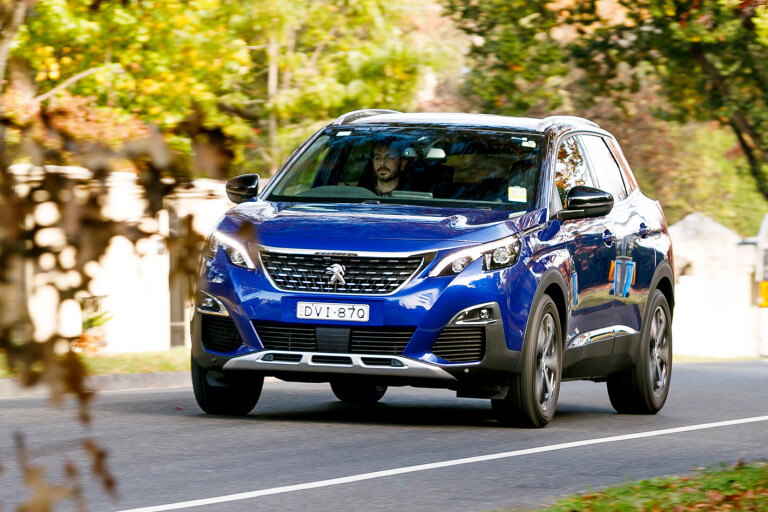
This makes her opinion a fascinating litmus test, because it is completely and utterly ignorant to both badge stigma and a car’s on-paper spec.
Our Magnetic Blue 3008 has been in the family for about five months, but it wasn’t until last week that my wife had cause to drive it. I’ll admit I was nervous on the Peugeot’s behalf about handing over the key; nothing to do with her driving, and all to do with what I thought might be a steep learning curve, given the 3008’s somewhat unconventional ergonomics.

The lady of our house very rarely drives cars that are not her own, and the experience of acclimatising to something new is more complicated in certain vehicles. Peugeot’s second handover scheme mentioned last month exists for this very reason. But I needn’t have worried; her first observation and overarching appraisal was that the 3008 is “very easy to drive”. She liked it a lot.
What’s interesting about that is people who move from car to car often (i.e. journos in this office) have found the weirdness of Peugeot’s head-up instrument display a little difficult to adjust to. For those unfamiliar with it, the main instrument cluster sits above a low-set steering wheel, so the driver must look over the top of it rather than through it to see data on the screen. It split opinion during Car of the Year testing and was described as controversial in the wrap-up, but it didn’t even rate a mention from the hugs and kisses.

It was a light-switch moment when I pointed it out, which was met with more approval. The only thing she didn’t like was the ride, describing its firmness as “a bit bumpy”. She’s right about that too, but it’s the ‘easy to drive’ comment that stuck with me. If I were a car company, that’s the sort of feedback I’d be happy with from somebody like her. She is not a car enthusiast, but she’s in the target market, and she’s exactly right. There is an ease of use about this car that makes it an enjoyable everyday accomplice.
French cars have come a long way, to the point that even this 3008 with all its interior intrigue and singular style still nails most of the basics. Showroom flair may sizzle at the dealership, but the most design-driven mid-size SUV still needs user-friendliness to win buyers, and if my wife gives the 3008 her approval, that’s mission accomplished.
Farewell
I WENT to school with a French kid for six months almost 20 years ago. His name was Lucien. I have never forgotten Luc because as a young Aussie everything about him was weird to me when we first met.

We were both foreign students at a secondary college in England, and that gave us a bond, even though Luc’s English was no better than my French. His family had a left-hand-drive Peugeot 504 that had come across the Channel with them, and that was the first Gallic car I ever rode in.
It seemed so much more interesting than my family’s Mazda 626, and by the time he left the school to go home I was really quite fond of that beige sedan. In fact, it’s the memory of the Pug that brought Lucien to mind.

Six months is enough time for a person, or an object, to leave a lasting impression. I’ve had six months to savour my Peugeot 3008 and, sadly, it’s now time to hand the keys back. I was wrapped up in the smoke and mirrors of its interior glamour at the outset, but the haze has since dissipated and I’ve spent weeks peering at its true colours. So the pivotal question is, do I still like what I see?
I’ve thought carefully about this, and can safely say that I do. I touched on its functional convenience last month, because utility is what made the 3008 a welcome addition early on, and it remains so, but the 3008 carries out daily duties with a layer of sophistication and elegance – especially inside – that transcends mainstream appliances. An emotional appeal comes from that, which I think plays into the Peugeot’s value equation despite the intangibility of the feelings it evokes. It’s something a Volkswagen Tiguan doesn’t have.
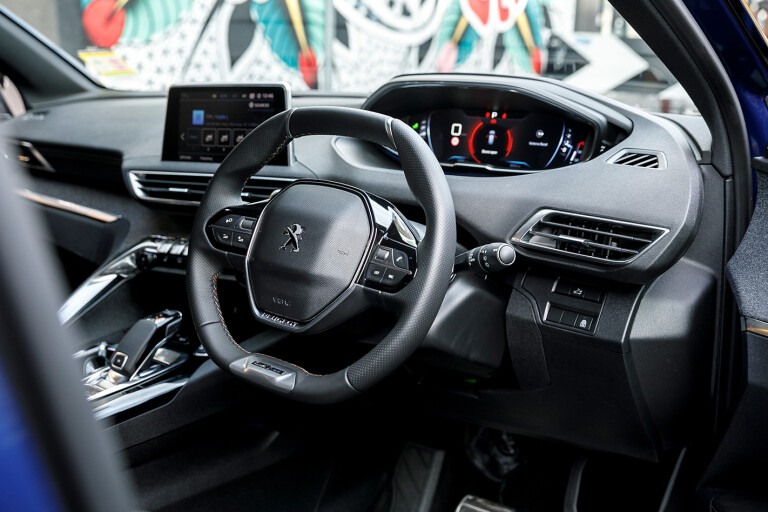
Some bits of tinsel haven’t added to my personal ownership experience, namely the massaging seats, and the perfumed climate control, which has three fragrances all a bit too reminiscent of the locker room at that same high school (Lynx Africa, anyone?). This car has, however, turned me on to the wonder of wireless phone charging and convinced me of Peugeot’s head-up digital dashboard.
The engine’s 121kW and 240Nm have proven sufficient, and real-world economy improved to an acceptable level after a wobble early on when it hovered as high as 11L/100km. Then there’s the excellent six-speed auto from Japanese gurus Aisin, which could be tacit admission from Peugeot that if you can’t beat ’em, you really should join ’em.

So would I buy one? The 3008 would definitely be on my shortlist. The hiccup we had with the fuel system didn’t help to quash question marks about French reliability, but the one-off issue and the way it was dealt with haven’t left a sour taste at all.
There’s nothing the 3008 does to offend or that I haven’t been able to find a workaround for, though before taking custody I felt sure the infotainment was going to be one of those things. That was a red herring. Same goes for cabin materials quality. Aussie consumers carry emotional baggage when it comes to French cars, but the 3008 proves they can be charming, with the substance to match. If Peugeot can get bums on seats, the 3008 in particular should go some way towards combating the status quo.
COMMENTS